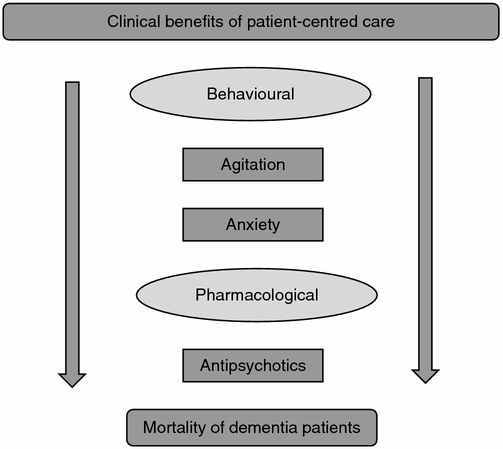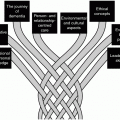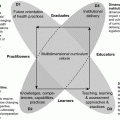- Patient-focused care
Providing care that is respectful of and responsive to individual patient preferences, needs and values, and ensuring that patient values guide all clinical decisions.
The support for a health care system that focuses on the patient is strong in Australia with many providers embedding patient-focused principles into practice. A person-centred care focus is also popular internationally, especially in countries such as the US, UK and Canada.
- Person-centred care
Person-centred care is the ‘treatment and care provided by health services which place the person at the centre of their own care and considers the needs of the older person’s carers’ (Victorian Government Department of Human Services, 2003).
Person-centred care is gaining more ground in dementia care and has evolved to become a synonym for good dementia care practice. The UK’s National Institute for Health and Care Excellence (NICE) clinical guidelines highlight that person-centred care reflects good practice in dementia care, with many principles of person-centred care reflected in its guidelines (NICE, 2006). The term ‘person-centred’ care, although used in other health areas before, in dementia is relatively new. The term has its roots in the work of Carl Rogers and his ‘client-centred’ psychotherapy. According to Rogers, the aim is to create a setting so that the client can come up with their own resolution of their problems, rather than the therapist providing advice (Rogers, 1961; Lane, 2000). The term ‘person-centred counselling’ in fact replaced the ‘client-centred’ term, with the view of recognising that the person who seeks counselling is an expert on themselves, whereas the actual therapist is the facilitator who seeks the patient’s self-actualisation (Brooker, 2004). However, it was not until the work of Kitwood that the ‘person-centred’ term found its way into dementia care (Kitwood, 1988; Kitwood, 1997). He supported the idea of shifting from the traditional approach of dementia care, which focused on the deficits of the person, to a model of care that values the personhood of the dementia patient. Kitwood emphasised that the term ‘person-centred’ care should be used with the view of highlighting communication and relationships during the process of dementia care (Kitwood, 1997). Dementia care mapping has been developed to assess the quality of care in dementia and is largely based on the person-centred care hence promoting patients’ personhood and a holistic approach to their care.
Carers of dementia patients, who follow a person-centred care approach, bring out the best in the people living with dementia. This also applies to those care homes that often have their mission statement based around this approach and therefore aim to provide good dementia care. In this regard, it is worth emphasising that there are three key principles of good dementia care (Cheston, 1998; Kitwood, 1997):
- regular and structured activity;
- activity at interpersonal, recreational and therapeutic level;
- reinforcing patients’ sense of worth and value.
What does person-centred care mean?
Brookersuggested that the term ‘person-centred’ care tends to mean different things to different people in various situations (Brooker, 2004). Therefore, articulating ‘person-centred’ care in a straightforward way is complex. To some, the term may imply individualised care; to others it is a value base. This is also obvious from various approaches that regard ‘person-centred’ care as a set of techniques of working with a patient with dementia in comparison to other approaches in which ‘person-centred’ care is based on communication with the patient (Brooker, 2004). It should also be recognised that, in practice, the person-centred care term is used interchangeably with terms such as ‘personalised care’, ‘patient-centredness’ and ‘relationship-centred care’. Overall, the term describes the relevance of relationships and collaboration between health care workers and patients and recognises their needs and reciprocity in relationships (ACSQHC, 2010). As a concept, person-centred care puts the patient first. This essentially means putting patients’ needs, feelings, preferences, experiences and well-being ahead of the disease, in this case dementia. Therefore, person-centred care is entirely and always focused on the individual person.
There are a number of definitions of person-centred care but none is currently globally accepted. One of the definitions provided by the Victorian Government Department of Human Services (2003) defines person-centred care as ‘treatment and care provided by health services which place the person at the centre of their own care and considers the needs of the older person’s carers’. This definition also considers the carers (i.e. service providers) and emphasises the importance of the collaborative and respectful partnership that should be in place between carers and patients (i.e. service providers and users). According to the Institute for Patient- and Family-Centred Care (n.d.), person-centred care:
is an innovative approach to the planning, delivery, and evaluation of health care that is grounded in mutually beneficial partnerships among health care providers, patients, and families. Patient- and family-centred care applies to patients of all ages, and it may be practised in any health care setting.
The World Health Organization (WHO) used the term ‘responsiveness’ over ‘person-centred care’ with the view of best describing how health care systems meet expectations in a number of domains, namely respect for people and their preferences, communication between healthcare workers and patients, as well as waiting times (WHO, 2000). WHO also supports carer and patient involvement in partnership initiatives with the aim of improving safety and quality of care (WHO, 2010).
In recognising, therefore, that ‘person-centred’ care is a composite term, Brooker (2007) proposed that in dementia care it should encapsulate four major components referred to as VIPS:
- valuing people with dementia and those who care for them (V);
- treating people as individuals (I);
- looking at the world from the perspective of the person with dementia (P);
- providing a positive social environment in which the person living with dementia can experience relative well-being (S).
Achieving person-centred care
According to the UK’s Royal College of Nursing (n.d.), there are some key considerations that assist individual carers in the achievement of person-centred care. These considerations are based on concepts that need to ensure:
In general, there are a number of approaches reported internationally that assist in achieving person-centred care. These include a variety of strategies generally aimed at improving patients’ knowledge (e.g. through training of health professionals about medicines and longer consultation times for patients); improving patients’ experience (e.g. getting patient feedback through surveys that support quality improvements, person-centred communication and longer consultation times); improving service use and decreasing cost (e.g. public reporting of performance, adequate dissemination of information in formats easily understood by patients) and improving health behaviour and health status (e.g. through development of communication skills for clinicians) (ACSQHC, 2010; Coulter & Ellins, 2006).
Engagement of carers and patients is a cornerstone in achieving person-centred care. The relevance of carers and/or family should be highly valued given their knowledge of the patient (e.g. history and routines) and their ability to reassure the patient in various situations of uncertainty, anxiety or even vulnerability. Carer involvement in patients’ care can be supported by designing strategies aimed at readjusting patient visiting times according to their needs, creating family response teams that alert health care staff on changes in patients’ status and creating partnerships with carers and/or families aimed at addressing patients’ needs (ACSQHC, 2010). Such strategies can contribute to the overall care of the patient and improve their overall experience as suggested by Frampton et al., (2008) who reported a 65% decrease in anxiety and improved overall patient experience as a result of patient-directed visiting hours.
Access to information and education by carers and patients is also a person-centred strategy that promotes empowerment. In this regard, patient personalised information, provision of printed and electronic information, as well as educational programs, improve knowledge and understanding of their condition and hence benefit patients’ care (Frampton et al., 2008; ACSQHC, 2010).
Approaches aimed at improving the design of the physical care environment for patients by creating a user-centred design have also been reported to be successful in improving patients’ experience of care. Service re-design has also been implemented in this context in the UK. This approach focuses on technical issues of the patient’s journey and it maps steps in order to identify potential problems in the patient’s care and hence generates solutions (Ben-Tovim et al., 2008).
Appointing carers and patients to advisory committees at governance level, in order to have a say in decision-making processes, is also important in ensuring person-centred care. This strategy can assist by having carers and patients providing information to policy makers on their needs and concerns, being involved in planning of patient care and innovative programs, having their say on changes affecting patients and carers, and helping to strengthen communication between various stakeholders in the patient care chain (i.e. family, carers, health care staff, administrative staff and patients). Appointment of carers and patients at governance level also encourages them to speak up and get involved in the care process (ACSQHC, 2010; Frampton et al., 2008).
Important considerations in achieving person-centred care also include ensuring that care providers offer an environment that supports person-centred care. In addition to creating an atmosphere that supports patient-centredness, providers should consider staff satisfaction and accountability strategies, as well as valuing training and ensuring that employees’ behaviour in fact reflects the organisation’s values (Shaller, 2007; Frampton et al., 2008).
Person-centred care in dementia
Who is the person?
Patients with dementia have unique characteristics owing to their disease. Dementia imposes various levels of functional decline (both physical and cognitive). Its progressive nature in relation to cognition, behaviour, as well as function tends to make patients with dementia more dependent on other people, especially in the performance of activities of daily living (Chenoweth et al., 2009). This translates into unmet complex needs of patients with dementia leading to behaviours that are need-driven (Chenoweth et al., 2009; Kitwood, 1997). Behavioural and psychological symptoms of dementia (BPSD), also referred to as neuropsychiatric symptoms, are a diverse group of non-cognitive symptoms and behaviours that occur in patients with dementia (Cerejeira, Lagarto & Mukaetova-Ladinska, 2012). These symptoms correlate with the degree of functional and cognitive impairment. Delivery of care in dementia patients is therefore often complicated by the presence of BPSD, which includes agitation, aberrant motor behaviour, anxiety, elation, irritability, depression, apathy, disinhibition, delusions, hallucinations, and sleep or appetite changes (Cerejeira, Lagarto & Mukaetova-Ladinska, 2012).
These issues place carers in difficult and stressful positions, and also lead to distress and institutionalisation of patients with dementia. Therefore, there are specific issues that should be considered when providing, or aiming to provide, person-centred care. The degree of care provision is dependent upon the individual with dementia. This process is driven by the carers’ ability to observe the person’s expression of well-being and, based on that, ability to evaluate the degree of person-centred care to be offered. This detailed observation and evaluation of a person’s well-being by carers assists during the process of planning, implementation and assessment of person-centred care (Chenoweth et al., 2009).
Principles of person-centred care in dementia
In achieving person-centred care, there are several considerations to follow in dementia care (Alzheimer’s Society, (n.d.); Alzheimer’s Australia, 2003; NICE, 2006). These include:
- viewing the person as an individual – this means shifting the focus from their disease as well as lost abilities as a result of their disease;
- viewing the person as a whole – this means considering the individual person’s preferences, interests, needs, qualities and abilities instead of focusing solely on managing their symptoms;
- making the person an equal partner in health care – this involves empowering the patient in the decision-making processes around their health;
- getting to know the person – this means knowing about the person’s life, history, family and values;
- treating the person with dementia with dignity and respect – this involves recognising and encouraging the person’s unique strengths during their management and treating them with courtesy at all times;
- taking into account the person’s cultural and religious beliefs.
In addition to the above individual considerations that assist dementia carers in achieving person-centred care, the Health Foundation (n.d.) outlines that person-centred care can only be achieved when:
- Staff possess adequate knowledge and skills to provide person-centred care.
- There are systems and processes designed to facilitate staff to act in a person-centred manner, and respond to service users’ needs and preferences.
- People who use and those who provide the service, co-design and co-produce it, enable support for person-centred care.
In 2010, the Victorian Department of Health issued keys to delivering person-centred care for persons with dementia in their publication regarding good practice for dementia care. These are summarised in Table 8.1.
| Person with dementia | Carers |
|---|---|
| Care should understand the person’s behaviour in relation to their unmet needs | Carer–person relationship is the key |
| Care should not be physical focused only and it should involve the whole person, including their social, cultural and individual identity | Carer has good information about the person during their care and shares this information with the management in order to develop appropriate strategies |
| Care should acknowledge person’s unique interests and life stories | Carers are in touch with their own concerns and feelings |
| Care should acknowledge person’s abilities, interests, preferences, values and spirituality | All staff are able to become experts in dementia care |
Why person-centred care?
A person-centred care approach reduces behavioural and psychological symptoms of dementia patients, and it also facilitates maintenance of patients’ personhood (Edvardsson, Winblad & Sandman, 2008). Person-centred care not only enables the person to become a partner of the interprofessional health care team, but also a key driver enabling the achievement of the best health outcomes for the person. In general, person-centred care provides benefits in terms of care experience as well as operational benefits. Engagement of various stakeholders (e.g. health care providers, patients, families) in care based on partnerships results in better quality and safety of health services provided, decreased cost and increased satisfaction of patients and other stakeholders involved (ACSQHC, 2010). Decreased length of hospital stay, decreased staff vacancy rates and an increased rate of hospital discharges have also been reported as a result of the person-centred approach (Stone, 2008).
Literature has also reported that person-centred care results in decreased infection rates and medication errors (DiGioia, n.d.), and improved clinical care (Jha et al., 2008) and functional status (Flach et al., 2004). Improved chronic disease management has also been reported (Stewart et al., 2000; Bauman, Fardy & Harris, 2003).
Specific clinical benefits of a person-centred care approach in patients with dementia have also been reported. These benefits can be non-pharmacological and pharmacological in nature (e.g. reduced agitation and anxiety as well as reduced use of antipsychotic medications). The Caring for Aged Dementia Care Resident Study (CADRES), which was a cluster randomised clinical trial of 324 people with dementia, reported that as an intervention, person-centred care significantly improved agitation compared to usual care (Chenoweth et al., 2009). A reduction in agitation of nursing home residents was also reported by Cohen-Mansfield, Libin and Marx (2007) through the introduction of a personalised care technique based on individual residents’ needs (Cohen-Mansfield, Libin and Marx, 2007). In addition to agitation, anxiety can also be reduced through staff training on person-centred care in relation to specific individualised bathing practices for patients with dementia.
Similarly, a reduction in use of antipsychotic medications for the management of behavioural and psychological symptoms of residents with dementia has also been reported in a cluster randomised study by Fossey et al. (2006). The use of antipsychotic medication in patients with dementia is still a debatable and complex issue as their benefits are modest at best for these patients and their use is justified only in limited situations. Approximately 80% of people with dementia receive antipsychotic medication for behavioural and psychological symptoms (Hosia-Randell & Pitkälä, 2005). Antipsychotics use in people with dementia has a number of adverse effects leading to deterioration of health and, furthermore, is associated with an increased mortality in this patient group. A recent Alzheimer’s Australia report titled The Use of Restraints and Psychotropic Medications in People with Dementia has highlighted the negative consequences of using antipsychotics in patients with dementia, including the fact that these drugs are not always appropriately prescribed with evidence suggesting their misuse in patients with dementia (Peisah & Skladzien, 2014). Therefore, as also highlighted in Figure 8.1, a person-centred care approach may reduce dementia patients’ mortality through reduction of behavioural and psychological symptoms, such as agitation and anxiety, and reduction of antipsychotic medication use.

Figure 8.1 Clinical benefits of person-centred care in dementia
Stay updated, free articles. Join our Telegram channel

Full access? Get Clinical Tree






